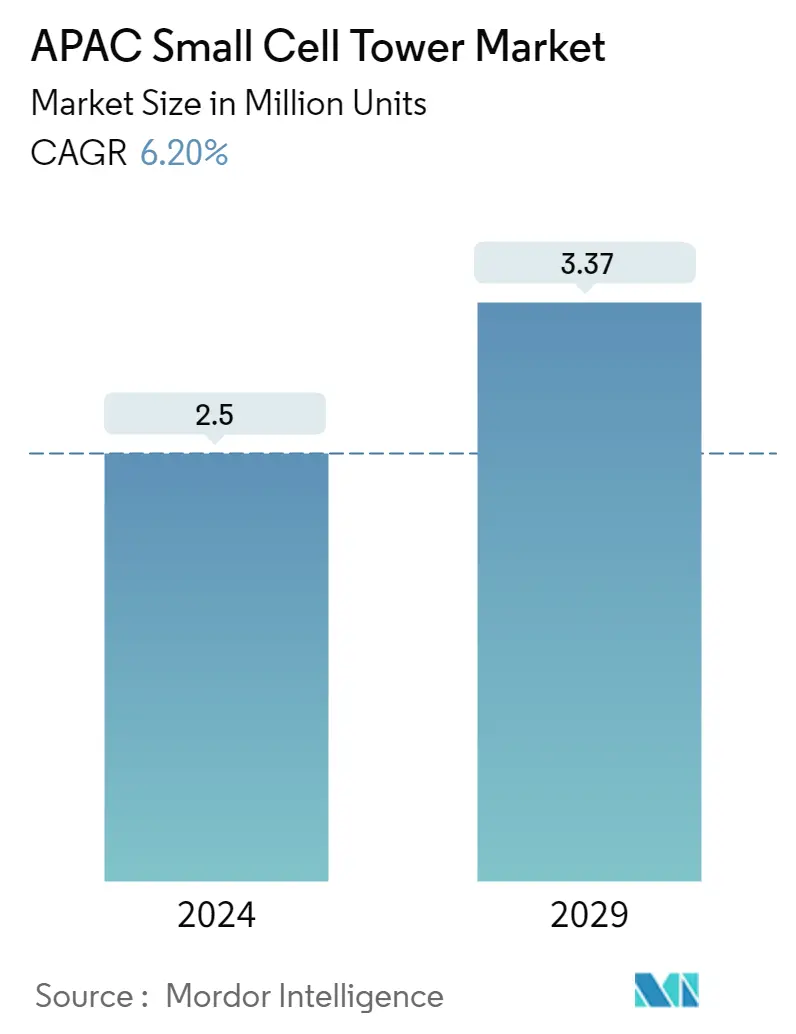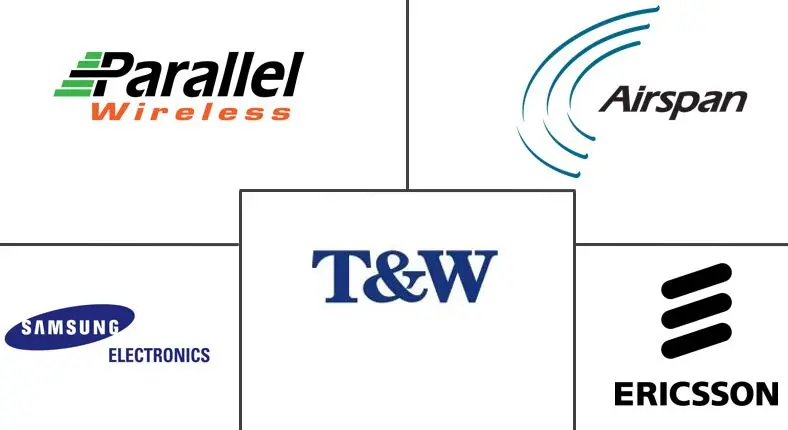Market Size of APAC Small Cell Tower Industry

| Study Period | 2019 - 2029 |
| Base Year For Estimation | 2023 |
| Market Volume (2024) | 2.50 Million units |
| Market Volume (2029) | 3.37 Million units |
| CAGR (2024 - 2029) | 6.20 % |
| Market Concentration | Medium |
Major Players
*Disclaimer: Major Players sorted in no particular order |
APAC Small Cell Tower Market Analysis
The APAC Small Cell Tower Market size is estimated at 2.5 Million units in 2024, and is expected to reach 3.37 Million units by 2029, growing at a CAGR of 6.20% during the forecast period (2024-2029).
Small cells are low-power cellular radio access nodes ranging from a few hundred meters to several kilometers. These base stations use little energy, are inexpensive, and may deliver high data rates by being placed close together to maximize spatial spectrum efficiency.
- Most of the 5G networks will likely be composed of small cells. Small cells are vital to the functionality of 5G networks because they provide the increased data capacity that 5G demands. They also help providers reduce costs by eliminating expensive rooftop systems and installation costs, and they are expected to help improve the performance and battery life of mobile handsets.
- In addition to the evolution of network technology and connectivity devices, the market is also driven due to the growth of demand for mobile devices worldwide. Such demand has been driving the shift in how IT services are delivered and has been providing the players in the market with significant opportunities for enhancing their presence across the Asia-Pacific region.
- Moreover, Small cells are essential today for the increasing number of linked devices and Internet of Things (IoT) applications. Installing microcell towers in the low-frequency spectrum is another area of focus for 5G telecom providers as they work to increase bandwidth options for their consumers.
- While small cells can ensure improved network coverage at a low cost, the deployment has brought in new challenges, such as the backhaul development of small cell networks.
- The COVID-19 pandemic has increased demand for wireless internet as people were restricted at home all day (due to lockdowns in many countries) and forced to work from home, connect remotely with their peers, and use the internet services for both work and entertainment. This has led to a surge in online traffic, which acted as a key factor driving the growth of small cell networks, which are easy to install and cost-effective.
APAC Small Cell Tower Industry Segmentation
Small cell towers are low-power, short-range wireless transmission devices that may cover a small geographic region or be used indoors and outdoor. Small cell towers play an important role in efficiently offering high-speed mobile internet and other low-latency applications in 5G deployments.
The Asia-Pacific Small Cell Tower Market is Segmented Application (Outdoor and Indoor) and Country (China, South Korea, Japan, India, Philippines, Rest of Asia Pacific).The market sizes and forecasts are provided in terms of value (USD) for all the above segments.
APAC Small Cell Tower Market Size Summary
The Asia Pacific Small Cell Tower Market is experiencing significant growth, driven by the increasing demand for mobile connectivity and the rapid development of 5G technology. Small cells, which are low-power cellular radio access nodes, play a crucial role in enhancing the capacity and efficiency of 5G networks. These compact base stations are cost-effective and energy-efficient, making them ideal for densely populated areas and indoor environments where traditional macro cells may fall short. The proliferation of IoT devices and the need for improved network coverage and capacity in both urban and rural settings further propel the market's expansion. The COVID-19 pandemic has also accelerated the adoption of small cell networks as remote work and online activities surged, highlighting the need for robust and reliable wireless internet connectivity.
China leads the charge in 5G adoption within the region, with a substantial number of 5G base stations already in place, facilitating widespread consumer access. The country's proactive approach has attracted global companies to enhance 5G experiences, particularly in indoor settings where high speed, capacity, and low latency are essential. The market is characterized by semi-consolidation, with major players like Samsung Electronics, Parallel Wireless, and Airspan Networks actively engaging in strategic collaborations and product innovations to capture market share. Recent developments include the expansion of 5G innovation labs and the introduction of new indoor connectivity solutions, underscoring the industry's commitment to meeting the growing demand for seamless mobile connectivity across various sectors.
APAC Small Cell Tower Market Size - Table of Contents
-
1. MARKET INSIGHTS
-
1.1 Market Overview
-
1.2 Industry Attractiveness - Porter's Five Forces Analysis
-
1.2.1 Bargaining Power of Suppliers
-
1.2.2 Bargaining Power of Consumers
-
1.2.3 Threat of New Entrants
-
1.2.4 Intensity of Competitive Rivalry
-
1.2.5 Threat of Substitutes
-
-
1.3 Industry Value Chain Analysis
-
APAC Small Cell Tower Market Size FAQs
How big is the APAC Small Cell Tower Market?
The APAC Small Cell Tower Market size is expected to reach 2.50 million units in 2024 and grow at a CAGR of 6.20% to reach 3.37 million units by 2029.
What is the current APAC Small Cell Tower Market size?
In 2024, the APAC Small Cell Tower Market size is expected to reach 2.50 million units.

